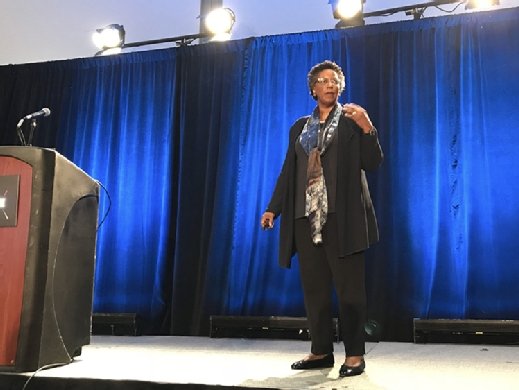Three capabilities all leaders of innovation possess
Harvard's Linda Hill tells IT execs at LiveWorx that in order to be leaders of innovation they need to champion three things. One of them is 'creative abrasion.'
Being a leader is never an easy job, but the job is getting harder, according to Linda Hill. To be a leader today, traditional management is not enough, you also have to help foster company-wide innovation -- or risk being left in the dust.
Hill, the Wallace Brett Donham professor of business administration at the Harvard Business School and co-author of the book Collective Genius: The Art and Practice of Leading Innovation, is in a good position to know that. She and her colleagues have spent the last decade observing leaders of innovation around the globe, trying to understand what makes them successful and searching for commonalities.
Speaking to an audience of IT leaders at the recent LiveWorx event in Boston, Mass., Hill said that even though there's a lot of research on leadership and a lot of research on innovation, there's actually very little research that looks at the connections between the two.
In her research on leaders of innovation -- studying successful people at companies like Google, HCL Technologies, Volkswagen and Pixar, to name a few -- Hill and her team certainly found differences in how these people went about their work, including cultural differences, organizational differences and varying leadership styles, she said. But they also found real commonalities in what these people did and why they did it.
Whether these leaders of innovation were working at an Islamic bank in Dubai, a social enterprise in east Africa or a luxury product brand in Korea -- they all championed three types of creativity that became part of their organizations' cultures and a key to their organizations' capacity to innovate. Hill dubbed them "creative abrasion," "creative agility" and "creative resolution."
Hill detailed these three capabilities and encouraged IT leaders to find ways to incorporate them into their own organizational cultures to foster innovation.

Creative abrasion
The ability to generate a marketplace of ideas through discourse and debate.
"You rarely get innovation without diversity and conflict," Hill said.
Organizations may do brainstorming sessions in which people can say whatever is on their mind without judgment, but it can't all be sunshine, rainbows and pleasantries. You need some abrasion and pushback to not only refine ideas but also develop a robust pipeline of ideas, Hill said.
"What you see in these [innovation-forward] organizations is people know how to inquire and they know how to actively listen, but, guess what -- they also know how to advocate for their point of view," Hill said. One of the organizations she and her team looked at actually taught their employees how to advocate for their point of view to help push creative abrasion.
Good leaders of innovation also understand that one of their key roles is to make sure that they -- and everyone else -- hear the minority voice, Hill said. "That does not mean you do what that minority voice says, but if you don't know what it is, then you haven't been doing things properly."
Creative agility
The ability to test and refine ideas through quick pursuit, reflection and adjustment.
In order to refine your pipeline of ideas even more, Hill said you need to go through the process of actually testing it, getting feedback and making the necessary adjustments -- and in a timely manner. Hill finds that many companies put in place lean startup or design thinking approaches to help organizations become better at being agile.
One of the organizations Hill observed decided not to run pilots anymore because if you run a pilot and it doesn't work, someone or something was "wrong." Instead, they run experiments.
"When you run an experiment, you learn something one way or the other and you move on to the next one," Hill said. "But if you do a pilot and it doesn't work, then usually there are politics around that. People often ignore the feedback they're getting or somebody pays the price because it 'failed.'"
Creating a culture that makes people feel comfortable running experiments and putting themselves out there without fear of retribution is crucial.
"So many people report feeling that they are, in fact, punished when they speak out, fail or have a misstep," Hill said. "If that is the case, there is not enough psychological safety in that environment for you to unleash the kinds of conversations necessary to hone your ideas."
Creative resolution
The ability to make integrative decisions.
Most innovations are really a combination of ideas; very rarely is the innovation all new, Hill said. It could be a new idea and an old idea combined to solve an old problem, or two old ideas that together solve a new problem, or some other amalgam of new and old.
"Unless you do decision-making in a way that you can actually combine ideas, you rarely get the innovative solution," Hill said.
As a result, what Hill sees in these innovation-forward organizations is they're very clear about who has decision-making rights, but they still do it in a more "inclusive and patient" way. By that she means they won't allow one group to dominate. They won't let the experts dominate -- something she notes Steve Jobs was particularly worried about because he often felt that this group was the least likely to want to see change because then their expertise wouldn't be as valuable as it was before. And these organizations don't let the bosses dominate either.
"They will also not compromise, which is what we often do in these situations -- go along to get along," Hill said. "Instead, they will have, if you will, a fight. They will actually go through the creative abrasion process again and they will design the next experiment to get more data in order to move forward."







